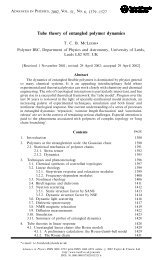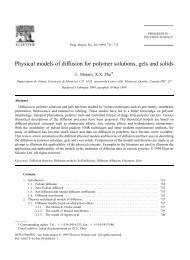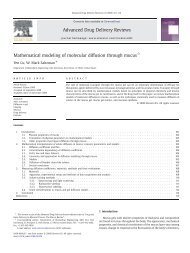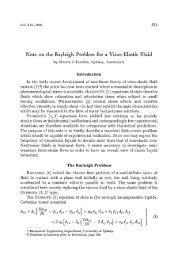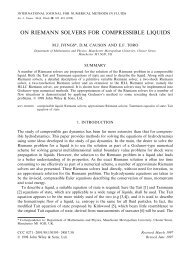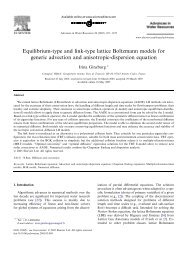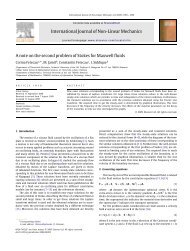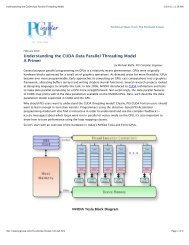Constitutive Equations for Polymeric Liquids
Constitutive Equations for Polymeric Liquids
Constitutive Equations for Polymeric Liquids
You also want an ePaper? Increase the reach of your titles
YUMPU automatically turns print PDFs into web optimized ePapers that Google loves.
172 BIRD & WIEST(1988) has given an overview of constitutive equations of the integraltype.TESTING CONSTITUTIVE EQUATIONS BYCOMPARISON WITH EXPERIMENTAnnu. Rev. Fluid Mech. 1995.27:169-193. Downloaded from www.annualreviews.orgby University of North Carolina - Chapel Hill/ACQ SRVCS on 11/05/11. For personal use only.All constitutive equations ultimately have to be tested against experimentaldata. There are two kinds of experiments that are currently being used:rheometric experiments (carefully designed experiments from which"material functions" can be extracted), and benchmark experiments (nontrivialflows suitable fpr testing both numerical methods and constitutiveequations).Rheometric ExperimentsMany experiments of this type are used, as explained in DPL-l (Chapters3 and 10) and in other books dealing with rheology. Examples of booksdealing specifically with the science of rheometry are those by WaIters(1975) and Dealy (1982). Meissner (1985) provided a review ofrheometricexperiments <strong>for</strong> polymer melts. Here we list just three rheometric experimentsas examples.STEADY SHEAR FLOW In steady shear flow between two parallel planes,Vx = yy, one can measure a shear stre;s T yx and two normal stress differencesTxx-' yy and 'yy-'zz; three material functions are then defined byTyx = -11Y (4)The (non-Newtonian) viscosity 11 is positive <strong>for</strong> all fluids, and it is usuallyfound to be a monotonically decreasing function of the shear rate y. Thefirst normal-stress coefficient, 'P 1, has been found to be positive <strong>for</strong> nearlyall polymeric liquids, and it decreases very rapidly with increasing shearrate; fragmentary data on liquid crystals suggest that they may havenegative 'P 1. The second normal-stress coefficient, 'P 2, has been found tobe negative and much smaller in magnitude than 'P 1. Measurements of 'P 2are quite sparse; the current state of the measurement techniques <strong>for</strong> 'P 2has been described by Ohl & Gleissle (1992). Measurement of'P2 <strong>for</strong> liquidcrystalline systems has been discussed by Magda et al (1991).SMALL-AMPLITUDE OSCILLATORY SHEARING MOTION In this type of experimenta fluid is placed between two closely spaced parallel plates, and oneof the plates is made to oscillate unidirectionally in its own plane with a(5)(6)




